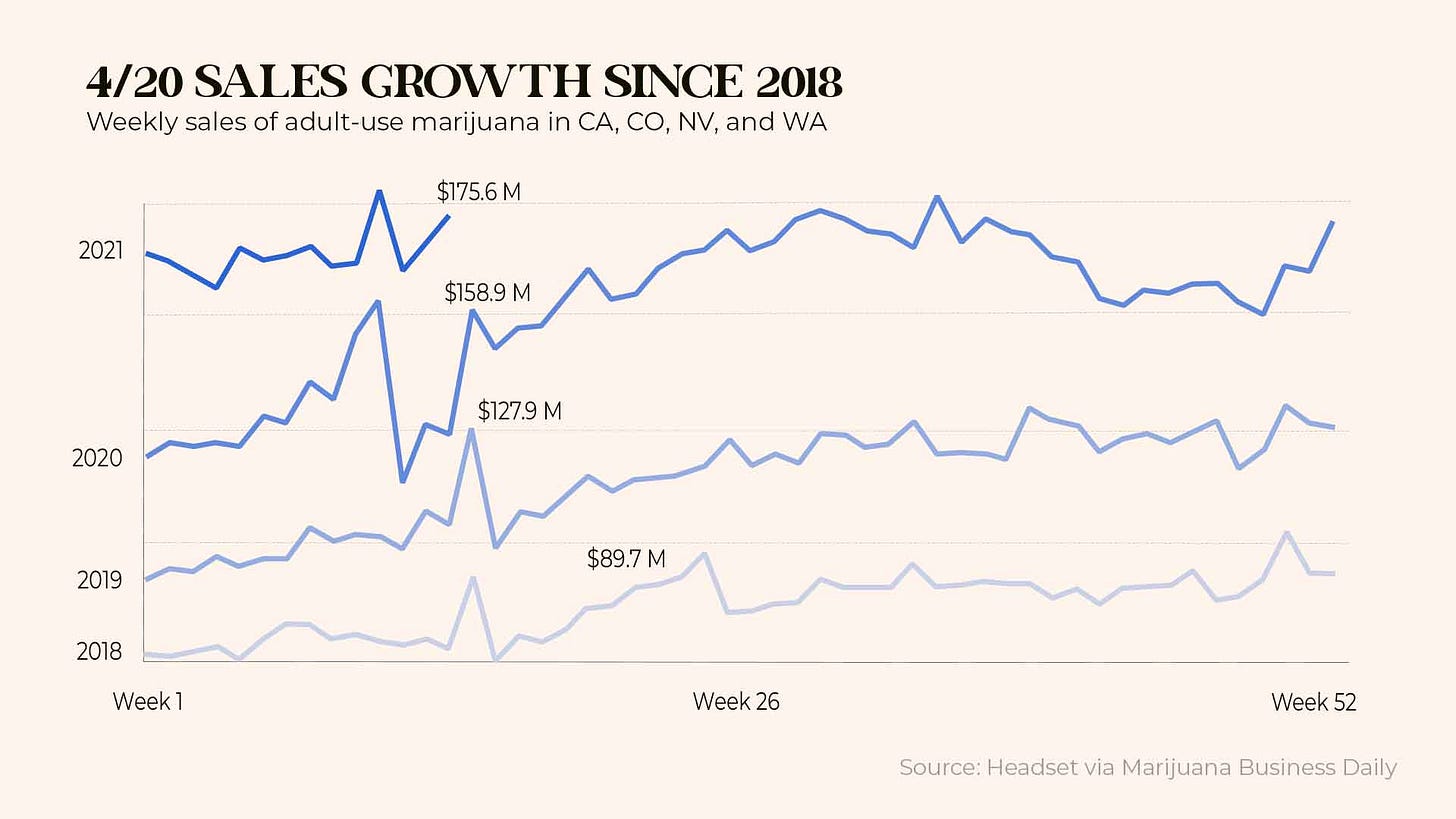How weed advertising evolved for the sophisticated stoner
Cannabis marketing is prioritizing a new clientele and with it, a new wave of alternative capitalism
Written by @alexc_journals, who might be a gardener after writing this.
A 3 minute read
THE LEDE
This week we bring you 3 pitches.
We focus on the economics of marijuana marketing and the weird hiccups involved in advertising a quasi-legal product.

THE BEST PITCH TO YOUR EDITOR
The news peg:
4/20, the unofficial marijuana holiday, marked a year where weed legalization in the U.S. progressed at an astonishing clip.
Record sales were recorded during COVID and there are no signs of slowing down. Coming out of the pandemic, the industry expects explosive customer demand in both products and events once social distancing restrictions loosen up.
The guiding question:
How has marketing weed evolved through barely being legal?
The answer:
There are two ways to look at the evolution of weed marketing.
A change in culture—women and baby boomers are the two fastest-growing customer segments.
Like any maturing industry, product stigma has steadily dropped, meaning that weed sellers are no longer pigeonholed into targeting the typical young male who initially embraced marijuana.Consumer data shows that most users are around age 42 and higher income than the general population. A more sophisticated consumer, therefore, requires more sophisticated marketing.
One trend to watchBrands are marketing their products to new users who are searching for more diverse effects than just getting high Consequently, products are being marketed based on more intangible qualities, like mood effects. According to Westword, “There are cannabis products named “Bliss” or “Arouse” that market based on feelings rather than THC percentages or strain names.”
This has led to increased diversity in cannabis content; from chefs who create “pairings” with pot to pop-up restaurants with a focus on cannabis cuisine.A change in tactics—cannabis sellers promote a socially conscious and legal-savvy business.
This might be pure altruism (or feeding the bottom line. After all, the more places weed is legalized, the larger the market and the bigger the pie).
Whatever the purpose, weed marketing has more aggressively promoted an idea of “alternative capitalism.” This is the idea that business is socially engaged and environmentally responsible, championing issues like incarceration to recycling for climate change to organic farming practices.


Weed marketing is more analog and less digital… for now
The increase in legalization of course doesn’t go hand in hand with a decrease of restrictions. If anything, the market is more heavily restricted and regulated than ever.
As a result, marketing cannabis has had to forgo traditional billboards for a more pre-Internet guerrilla marketing approach—popularizing in-person or in-store pop-up events, working with influencers, and even hosting virtual smoking parties.
(Snoop Dogg’s looked pretty fun. Perhaps we’ll report on the front lines next year.)



The takeaway:
Weed marketing has had to evolve both to incorporate a more diverse consumer base and embrace social activism, whether that be by necessity or choice.

There’s no doubt that recreational cannabis use will continue its upward trajectory and more states are sure to follow with legalization. As a result, weed businesses will continue to evolve their marketing to sophisticated consumers—both to serve their own bottom line, and to stave off an existential threat as more competitors enter the market.
Diverse sources worth interviewing:
The Cannabis Marketing Association: This group could not be a more perfect resource since they literally host informational sessions for marijuana businesses to help evolve their marketing tactics for a growing market.
Weedmaps: As a major marketplace player in the cannabis industry, they have taken on some of the largest-scale efforts to promote social justice reform. They’ll be able to speak on the need to embrace alternative capitalism tactics in a quasi-legal industry.
OTHER PITCHES WORTH EXPLORING
Black Cannabis Magazine was launched on 4/20 with Whoopi Goldberg on the cover. This media company reports on BIPOC and its inextricable relationship with cannabis and legalization.
How are niche media ventures trying to marry racial equity conversations with an evolving image of cannabis?Tim Jackson’s book Prosperity Without Growth talks of creating “an economics fit for purpose.” There seems to be no better case study than cannabis as it slowly legalizes.
Is legalizing weed similar to any other products that were slowly legalized? More importantly, can we compare apples to apples? Will cannabis legalization inspire more socially conscious businesses across the board, or is it a unique space?
ADDITIONAL SOURCES
Challenges of Marketing Marijuana
Cannabis Marketing Association
This 4/20, brands’ efforts range from decriminalization advocacy to fun social pushes
For 4/20, Weedmaps Towered Over Times Square With a Message Against Incarceration
Three takeaways from 4/20 cannabis sales data
WE’LL SEE YOU ON THE WIRE
Want another pitch in your inbox in time for your next pitch meeting?
Want to share this pitch with another journalist who might want to run with this story?
See something we should have added, corrected, or have a tip for a future story?
Publishing this story? Tell us and we’ll put it in our next newsletter!




